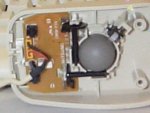Having built one of Brian's Jamma PC interfaces, put the PC in the cabinet,
and installed all of the software I began to play some of my favourite games.
It soon became apparent that several of the games I liked best
needed something other than a joystick for that fine `fingertip' control.
I started off thinking about adding a spinner to my machine. I could then play games like Arkanoid and
Clowns and have much better control over the bat. A little more thought, and I decided that a tracker ball
would not only give me accurate control for those sort of games, but, would also allow me to play missile
command, quantum and irritating maze (it's good for star wars too, until I get around to building a yoke!)
First problem was where to get a tracker ball from, buying them new is expensive. As luck would have it, I
was visiting Brian and had mentioned the idea to him. He said he had thought about it, and had in fact, had
already procured a nice Wico trackball assembly from a deceased Atari cabinet. In just a few moments
(after a rapid search under the two pinball machines and the spare bed) I had a complete tracker ball!
Wiring it up should be simple, I'd do a quick scan of the web, and some clever chap would have published
the exact circuit I need, except, nobody had (not that I could find anyway). All of the machines on the
Jamma PC ring that I found with tracker balls fitted, had used an interface board from Happ controls, at a
cost of $50 or so.
I checked Happ's web page, and after reading about the interface board (tracker ball to serial interface,
supports two buttons) I thought that this hardware sounded familiar, so I proceeded to dismantle my poor
little mouse.
Mice seem to work on the same principal as the tracker ball, (except for the odd ones). The movement of
the ball rotates plastic vanes between an LED and a receiver. The hardware then decides (from the number
of pulses from when the light can shine through) how far the ball has rotated (and from which order the
pulse hits the two receivers) in which direction it was moving.

However, if you look closely at the vanes on the tracker ball, and compare them to the vanes on the mouse,
you may find that they are different. The tracker ball has large open slots with much thinner plastic spokes.
I estimated this to be 20% dark (no light) and 80% light (or 20/80 ratio - see picture for an example). The
logitech mouse I was examining was drastically different, with very thin slots to allow light through on an
otherwise solid disk. (95/5).
Diagram of a part of the optical encoding disk of a mouse

I had a few other makes of mice hanging around (in various states of non-working), so I proceeded to pull
them apart and see what they were like. A Genius Netmouse was about 40/60, an unbranded cheap mouse I
had was about the same, and the microsoft intellimouse (on my wife's PC) was about 60/40. None the same
As the tracker balls vane, so would they be any good ?
I tried wiring up to the unbranded mouse, since it was the cheapest anyway, and tried it on a PC (with
Micro$oft Windows). If I moved the tracker ball slowly, it worked perfectly, I could move the mouse
pointer around the screen quite accurately. But, If I spun the ball quickly, then it would only move the
pointer a very short way. Was this caused by the difference in vane size, or would I be buying the Happ
interface after all. (The Happ interface is also made for the tracker ball that they sell, so that may not work
with a Wico anyway!)
Back at work, I checked a few more makes of mice out, until I found that the Mitsumi mouse that was
provided with our last batch of machines had vanes almost identical in ratio to the tracker ball. (25/75), plus
they were cheap to buy (about £3.00 each) and better still, one of the batch we had, did not register button
presses properly! (better for me, anyway)
The mouse was a Mitsumi Electronics Serial Mouse, I have scanned the label I removed from the bottom in
case you wish to search out one for yourself.
Label of mouse used

Please bear in mind that tracker balls from other companies may have different vanes, so check them out
yourself before choosing the mouse!